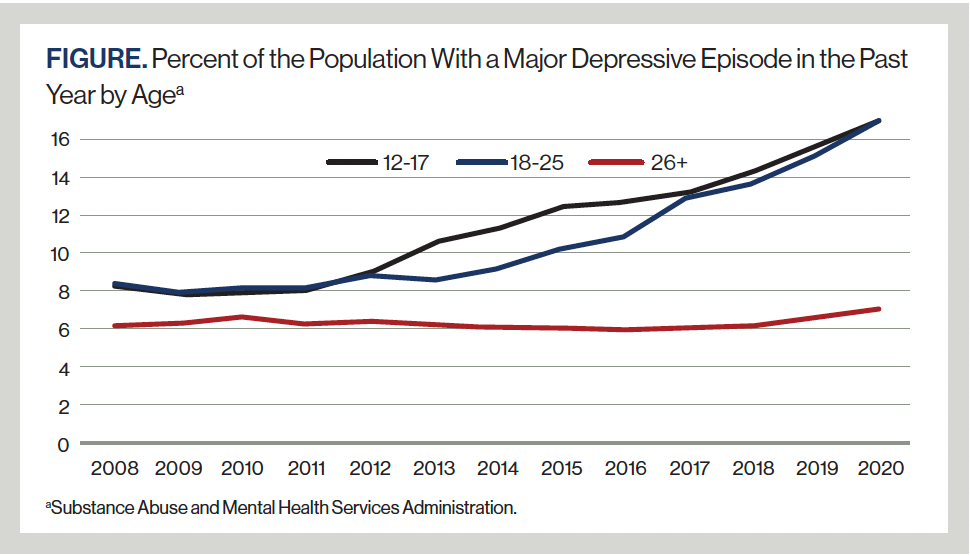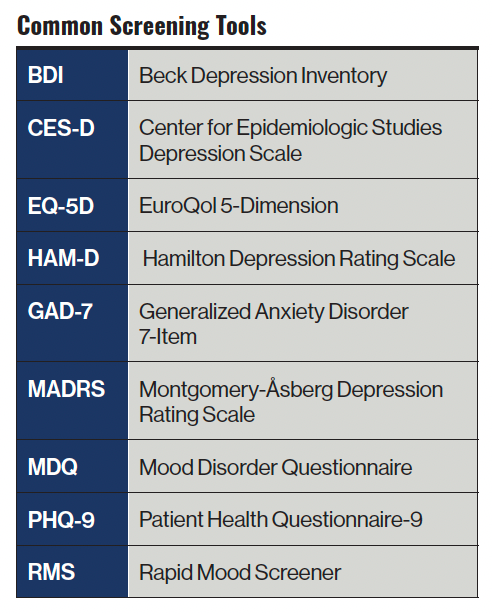Publication
Article
Psychiatric Times
Addressing Unmet Needs and Clinical Challenges in MDD
Author(s):
Here are 9 things you need to know about the clinical management of major depressive disorder.
Solid photos_AdobeStock

During a recent PsychView custom video, moderator Gus Alva, MD, and colleagues Charles Brendan Montano, MD, and Carmen Kosicek, MSN, PMHNP-BC, discussed the practical considerations and clinical management of major depressive disorder (MDD), highlighting the need for more efficacious treatments to fulfill current unmet needs in the management of MDD. What follows are 9 takeaways from the discussion.
Figure. Percent of the Population With a Major Depressive Episode in the Past Year by Agea

1. Understand the real goal—treat to remission.
Although seeing symptom and quality of life improvement is good, the expert panel agreed that achieving remission should always be the goal in MDD treatment.
“We need to put the fire out, and we’re not putting it out,” Montano explained. “We’re not looking for response. We’re really looking for total remission. That’s the goal. Until we have that, we still have fire burning in the central nervous system. There’s still this need to put out the embers.”
2. Get it right the first time.
Research and experience consistently show diminishing returns for patients with each new antidepressant trial and each new course of depression, the experts said.
“Really, the goal is to put the fire out,” Montano reiterated. “And without getting there the first time, things are worse for the patient. They are not recovering, and they are more likely to have recurrences and worsening of depression over time....We need to try to get it right the first time.”
Case Example
Montano shared an example of a patient he treated with a selective serotonin reuptake inhibitor (SSRI) and an augmentation agent for year after the patient’s first serious episode of depression. “He got better, but then his wife got severely depressed. And then there was more family stress, and his daughter got depressed.
He went into another severe depression that wouldn’t respond to an SSRI drug,” Montano said. “I ended up having to augment again. I told him, ‘Look, first time it was a 50/50 chance [of a chronic recurrent episodic problem]. This time, I think you’re on it probably for the rest of your life. But we’ve got to monitor side effects and make sure that it’s the right drug for you.’”
3. Recognize and prevent relapse and all negative consequences of incomplete recovery.
“Think about adverse childhood experiences,” Montano noted. “What we’re doing is we’ve got an incubator for worsening mental health over time if we don’t get aggressive at treating MDD and reaching out and treating people who need it.”
4. Consider all treatment options—psychopharmacology and otherwise—to help achieve the best response.
“We have over 35—I think we have 37—antidepressants last I counted in the United States,” Montano said. “Most primary care docs know how to prescribe 1, 2, or 3 at the most. And that’s only one little way of approaching depression. Although it has impact, it doesn’t have enough. We are not engaging and using all the resources. And that’s not just antidepressants. It goes beyond that. It goes to transcranial magnetic stimulation, electroshock therapy, deep brain stimulation, all kinds of other modalities that are still available.”
5. Ask about comorbidities and functioning.
“Everyone has a different picture of what depression looks like,” Kosicek shared with her colleagues. “Some people can barely function, and some can go to work and then come home and cannot get anything done whatsoever. Where others can’t even get out of bed.”
She suggested asking oneself, “What else is going on? What else is happening in the blood work? Is there something metabolic going on? What could it be? It just [runs] the gamut from diabetes to is there high or low white blood cell counts? What’s going on with thyroid? All of these questions truly come into play because if the patients are not presenting and knowing how to tick those DSM metrics, sometimes we miss it.”
6. Make screening—and rescreening—a priority.
“We can’t just treat and forget. I have to remind my staff every day if I haven’t seen that patient in 3 months, make sure they get a PHQ-9,” Montano said. “Doing repetitive screening with a PHQ-9 is going to bring that symptomatology out. Do they have a primary sleep disorder that will show up? Do they have ADHD? Believe it or not, 2 of those questions will often show up when you’re doing a PHQ-9. So not forgetting that this disease is chronic, recurrent—that’s how I think of it—and that you need to keep screening.”
Common Screening Tools

Kosicek agreed and said these screens help clinicians “know what kind of depression we’re dealing with.”
“A lot of times screens aren’t used because our EHR systems do not have all of those scales. GAD-7 and PHQ-9 are pretty common, but it’s really important for providers to push for the implementation of either the MDQ or the RMS. I like the RMS because it’s quicker,” Kosicek said. “That absolutely is something that can be added to the template.”
Montano also checks in frequently with patients using a simple scale to further guide treatment decisions. He asks patients, “If 10 out of 10 is the best you’ve ever felt and 0 is lower than whale manure, where are you with your depression right now?” As time progresses, he asks again, “Where are you on that scale?” Even if it improved from a 3 to a 6, he asks, “What’s missing for you to be a 10?” That answer, he explained, is where the chronic intermittent recurrent phase is always hiding.
Kosicek uses that same approach to help patients consider a different medication, even when they are weary of switching. She tells patients, “I’m glad you’re at a 6. If you ever feel that you want to be at an 8 or a 10, let me tell you what’s out there.” Then she shares medication options and why she thinks one may be better than another.
“I showcase hope. I encourage patients to go to the websites and look it up themselves.—To look at the data [from] hundreds of other people just like them and how they are [better] now.”
7. Time is important. Be quick to act and react.
Reaching patients who really need treatment and initiating treatment quickly are essential to positive outcomes, according to the experts.
“Don’t wait a month after giving an antidepressant to follow-up,” Montano suggested. “The only reason these folks are taking their medication is because they have faith in you and in the system. Having a phone call at 1 week and having them back in 2 weeks at the most would be the thing to do. We know data [show] that they’re going to have some improvement if they’re going to do well long term on the initial antidepressant.”
The importance of timing and being quick to respond is one of the reasons Montano is excited about the newer rapid-acting antidepressants. “When patients get the very quick resolution of those symptoms, they can take a breath of fresh air and say, ‘There’s hope—there’s hope for me that I will get out from under this blanket of depression,’” he shared.
8. Challenge outdated formularies and advocate for your patients and the field.
“I just cannot imagine in oncology prescribing medications from 30 or 40 years ago just because that’s on the formulary,” Kosicek told her colleagues. “I just cannot imagine in a medical device setting saying, ‘Well, I’ll take that old knee replacement [even though] I can’t bend it all the way.’ But that’s what we do here….It is time for us in psychiatry to stand up and stand strong that the evidence is there—and it’s overwhelmingly there—and our patients deserve it.”
Kosicek routinely sends emails to utilization review explaining the need for certain medications. “It’s not a dissertation. It doesn’t even have to be sourced and referenced, just 3 or 4 sentences. But it’s imperative that we all engage at this level so that we truly have access to medications to prescribe for our patients that are so needed.”
9. Get excited about future treatments.
“We went from the tricyclics to the SSRIs because of the lethality,” Montano explained. “They were good drugs, but they also hit so many targets that weren’t the right targets. Now we’re trying to refine and look at the targets, and we’re looking at glutamate and GABA and multiple other targets as well.
“I do think that when we look back maybe 20 years, 15 years from now, when these drugs have past clinical trial and are in play, they’re going to be cleaner, they’re going to have less adverse events associated with them,” he added. ”They’re going to be very effective—and hopefully will be the answer for the future.”







